| کد مقاله | کد نشریه | سال انتشار | مقاله انگلیسی | نسخه تمام متن |
|---|---|---|---|---|
| 6434531 | 1637150 | 2016 | 17 صفحه PDF | دانلود رایگان |
- Unreported Early Miocene erosional troughs are identified in the South China Sea.
- Erosional troughs were eroded by E-W-trending bottom currents.
- The paleoceanography study in the northern South China Sea extends to Early Miocene.
The paleoceanography of the South China Sea (SCS) is poorly understood, although recent cruises and an ODP expedition (Leg 184) have provided a useful general framework. Here we report previously unrecognized multi-km scale sedimentary structures consisting of coupled ridges and troughs within the Early Miocene strata, using high-resolution 3D seismic data from the northern SCS margin. The troughs are interpreted as linear and/or arcuate erosional features which truncate the underlying strata. They range in orientation from E-W in the southern part of the study area to nearly NE-SW in the northwestern part of the study area. The spacing of erosional troughs varies from less than 0.1Â km in the southern part to more than 3Â km in the northern part, and they are about 50-1500Â m in width, with a relief of 10-90Â m. The erosional troughs are parallel to the regional strike of the Early Miocene slope of the northern SCS. From their internal geometry, context, regional distribution and most importantly their orientation relative to the paleo-slope gradient at the time of their formation, it is argued that they formed due to the action of bottom currents linked to the broader paleo-circulation regime in the basin. We infer that the paleo-bottom currents intruding from the Pacific flowed along the northern SCS slope, resulting in the occurrence of localized erosional troughs as deep water masses impinged on and interacted with the sea floor topography. This study provides new insights into the Early Miocene paleoceanography of the SCS and demonstrates the utility of 3D seismic data to enhance our understanding of paleo-bottom current circulation regimes.
Journal: Marine and Petroleum Geology - Volume 77, November 2016, Pages 75-91
